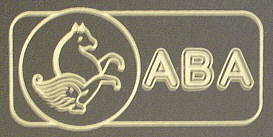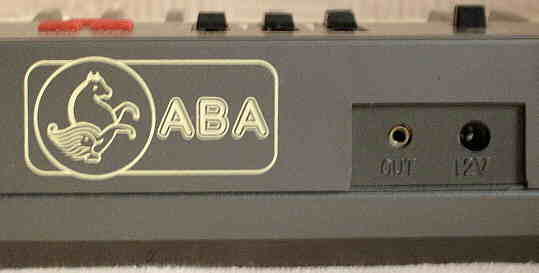 _ABA-88
(squarewave keyboard with accompaniment & analogue rhythm)
_ABA-88
(squarewave keyboard with accompaniment & analogue rhythm)
This keyboard looks like a cross of the VTech Rhythmic 2 and the Testron. Like the Testron it is stereo and has a bronze coloured case which is a little wider than the keyboard, but the functions resemble rather the Rhythmic 2, and the case is also flatter and less deep, rather like the Letron. Like the Rhythmic 2 it employs a Yamaha 4 channel squarewave soundchip with some additional analogue percussion. Unfortunately the accompaniment of the ABA-88 is really boring because it refuses to do a real single finger chord mode.
This keyboard was also released as Anitech KS-88 (seen on eBay).
| base & tom | = low & higher squarewave blips |
| snare (?) | = shift register noise |
| tambourin | = analogue transistor noise |
 On
the back is a white "ABA" logo with the front half of a winged horse that
looks quite Arabian. Most case details resemble the
Testron. On
the back is a white "ABA" logo with the front half of a winged horse that
looks quite Arabian. Most case details resemble the
Testron. |
Like the Rhythmic 2 it features as well the demo melody "Blue Danube" (which is the demo of my HBATEC keyboard) as "For Elise" (which is the demo tune of the Testron), although all versions are arranged differently. The demo tunes of this instrument sound extremely off and weird; their accompaniment keeps playing with arpeggio in always the same key (i.e. no chord changes) and thus sound extremely disharmonic. I don't know whether this was intended as a bizarre sort of oriental free jazz medley, or if the programmer of this demo rather typed in the notes within few minutes without ever minding or verifying how it sounds. (The oriental winged horse "ABA" logo suggests that it was possibly built by Arabian countries with their typical music style in mind.)
Interesting for playing are the 5 semi- OBS sound buttons those can be also pressed while keys are held down without stopping their notes. By rhythmically pressing these buttons many arpeggiator- like timbre changes can be created, though this button field can be regarded as a realtime sound control, although it responds a bit slow. The static voice assignment of the instrument is a little annoying, because in any chord modes only 1 voice remains for the user selected sound in the right keyboard section, no matter how many voices are really actually occupied with chords or other accompaniments.
The automatic accompaniments insert a sort-of automatic fill-in every 4 measures, which can be a little confusing, but generally sounds nice. Unlike Testron and similar wonderful no-name instruments, the accompaniment of the ABA-88 works really lousy, because with rhythm there is no difference between "fingered" and "single finger" mode; in both modes it always behaves like a simple "single finger" mode, which makes it (despite optional arpeggio) very stubborn and boring sounding. Only with rhythm off there is a difference between both modes; "single finger" then behaves like a key split feature with 3 note polyphony to the left and 1 note to the right keyboard half. The instrument makes also no use of the digital metallic cymbal sound of the YM2163 despite it would have sounded more natural than the transistor and shift register noise it uses instead. Possibly this instrument was originally designed for a predecessor of the YM2163 soundchip, which didn't feature these percussion sounds.
Likely this instrument hardware was a predecessor of the Rhythmic
2 and possibly even of the Testron, despite the capabilities
of its automatic accompaniments is so extremely far away from the latter
that I almost can't imagine this. The ABA-88 appears quite half- baked;
possibly its CPU even went into production with a severe software flaw
that was discovered too late.
| removal of these screws voids warranty... | ||
 |
||
|
|